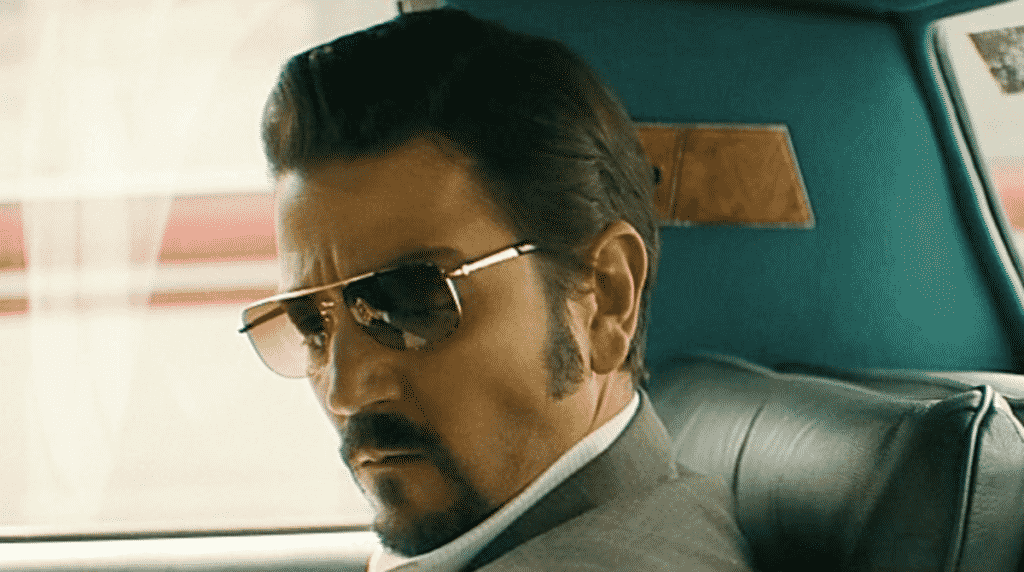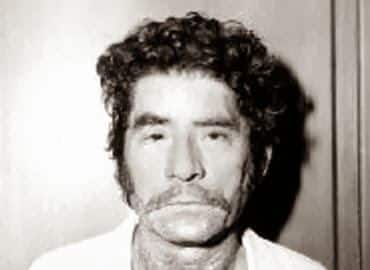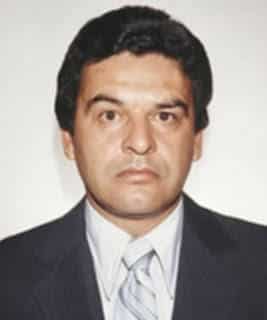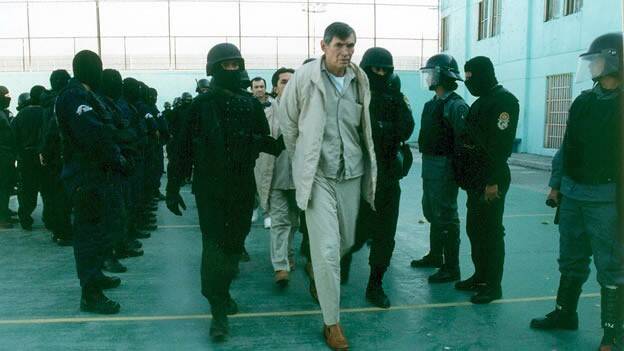Over 18 years, Miguel Ángel Félix Gallardo built one of the world’s most extensive drug operations, earning the title El Jefe de Jefes (“The Boss of Bosses”), or El Padrino. You may know him well from Diego Luna’s depiction of him in the Netflix show Narcos: Mexico.

Félix Gallardo’s Guadalajara Cartel unified the Mexican drug trade until his arrest for the murder of DEA agent Kiki Camarena. This moment was the catalyst for the cartel wars we’re all too familiar with today. Let’s take a look at the life of the Godfather of the Mexican drug trade, Félix Gallardo.
The Early Life of Miguel Ángel Félix Gallardo
Félix Gallardo was born to a low-income family on a ranch in the northwestern state of Sinaloa, Mexico. In his diary, he recalls massive inequality in Mexico and how impossible it was for someone like him to better their lives.

When he turned seventeen, he got a job as a police officer in the famously corrupt Sinaloa police department. The job didn’t pay well, and seeing the corruption at work could have been a primary reason he turned towards a crime life.
At some point, he got a job working as a bodyguard for Sinaloa governor Leopoldo Sánchez Celis, who eventually made him the godfather of his son Rodolfo. His close connection to Sinaloa politics would subsequently help him build his cartel.
Forming the Guadalajara Cartel
Félix Gallardo met Sinaloa drug lord Pedro Áviles Pérez while working for Celis.
Pérez was known as “El León de la Sierra,” or mountain lion. He was one of the most influential of the first generation of Mexican drug smugglers. His biggest claim to fame is that he was the first known drug smuggler to use planes to get into the United States, something the Guadalajara cartel would later perfect.

Gallardo and other crucial future cartel members cut their chops working in the Áviles organization. It was there that he built the other political connections that made him the perfect man to unite Mexico’s drug factions.
After Pedro Áviles Pérez died in a shootout with the police in 1978, Gallardo took over his drug routes. His co-founders were Rafael Caro Quintero, whose brother founded the future Sonora cartel, and Ernesto Fonseca Carrillo, the uncle of the future Juarez cartel founder.
How Miguel Ángel Félix Gallardo Got into the Cocaine Trade
Over the next couple of years, Félix Gallardo united the disparate Mexican drug factions of Sinaloa, Tijuana, Juarez, and Pacifico Sur. They primarily smuggled marijuana and even boasted the 1,344-acre Rancho Búfalo plantation.
Realizing the potential profits, they soon made a move into the cocaine trade. The Colombian cartels had smuggled most of their product through Florida, but the US Drug Enforcement Agency was beginning to step up their efforts. The next logical place was the 1,954 long US-Mexican border, which the Guadalajara Cartel controlled.
Remember that scene in Narcos where Félix Gallardo flies down to Colombia to meet Pablo Escobar? It didn’t happen like that, but they did strike up a partnership to smuggle cocaine across the US-Mexican border. Instead of taking a direct payment, Gallardo asked for 50% of the cocaine. This agreement turned out to be extremely profitable, bringing the cartel $5 billion per year.
The cartel had it made. The head of the Mexican Direccion Federal de Seguridad (DFS) was on the payroll and protecting the cartel from law enforcement. This would be like if the FBI were protecting your criminal enterprise in the US!
As long as the right people got paid, the cartel could operate with impunity. At least, until they made a significant mistake that would bring the wrath of the entire United States government down on them.
The Murder of Kiki Camarena
The DEA assigned special agent Enrique “Kiki” Camarena to Guadalajara in 1980. He wasted little time in becoming a major thorn in the cartel’s side.
Through a network of informants and some impressive undercover work, Camarena discovered and destroyed plantations in Zacatecas State. He also found and destroyed the 2,500 acre Rancho Búfalo plantation in Chihuahua.
These marijuana grow operations happened under the watchful eyes of Mexican DFS, local police, and politicians connected to the cartel. The fact that Camarena was unraveling these connections is likely why the cartel killed him.

On February 7, 1985, corrupt Jalisco police officers picked him up outside the US consulate. A month later, the DEA found his remains outside of Guadalajara. He was virtually unrecognizable. They crushed his windpipe, jaw, cheekbones, and nose and drilled a hole in his head.
They had brought Camarena to a house in western Guadalajara owned by cartel co-founder Rafael Caro Quintero and tortured him for thirty hours. In the end, they punctured a hole in his head with a tire iron.
When questioned by the DEA, Gallardo denied involvement, but the writing was on the wall. The full wrath of the DEA was coming.
The US launched Operation Leyenda in 1985 with the sole goal of finding Kiki Camarena’s killers. It was one of the most extensive operations in DEA history.
Initially, the operation couldn’t make the connection between Camarena and Gallardo. Their informants thought Gallardo ordered the death, but it would have been Quintero who carried it out. There was speculation even speculation that the CIA was involved. Audio of the murder helped them make their case.
The Arrest of Miguel Ángel Félix Gallardo
Initially, Mexican police only arrested Rafael Caro Quintero and Ernesto Fonseca Carrillo but spared Félix Gallardo because of his extensive political protection. For the next two years, he lay low in Guadalajara before Mexican police arrested him in 1989.
Ironically, he had known some of those who arrested him since his days in the Sinaloa police force. His friends had sold him out.
The government charged him with the murder of Enrique Camarena, in addition to drug and racketeering crimes. He was worth $500 million at the time of his arrest. The state sentenced him to 37 years in prison.
The arrest of Félix Gallardo kicked off many high profile corruption arrests in the Mexican government and police. Numerous police commanders were arrested, and close to a hundred lower-level officers deserted rather than face prosecution.
The Legacy of the Guadalajara Cartel
After his arrest, Félix Gallardo decided to divide his drug empire into territories. Decentralization would make it harder to topple the organization through high profile arrests. These divisions were the templates for many of the largest modern Mexican cartels once he lost the ability to run national operations.
Félix Gallardo divided the territory amongst his top lieutenants.
The Arellano Félix brothers, his nephews, controlled what became the Tijuana Cartel. Amado Carrillo Fuentes got what became the Juarez Cartel. Joaquín Guzmán Loera (better known as El Chapo) and Héctor Luis Palma Salazar controlled what became the Sinaloa cartel. The Sinaloa and Tijuana cartels are still two of the top three largest cartels today.
While the likelihood that law enforcement could easily topple the decentralized cartels was lower, Félix Gallardo didn’t foresee the violence. He was first and foremost a businessman who used violence as a last resort.
Other cartels don’t have any qualms about using violence to muscle into each other’s territories. Since 2006, there have been an estimated 150,000 deaths related to organized crime in Mexico. In 2018 alone, the number killed in drug crimes was 33,000. Mexico’s war on drugs that started in 2006 has failed, as most do, but that’s a topic for another article.
Things have only escalated over the last decade. Upcoming cartels like the Jalisco New Generation Gang are responding to increased police action with escalating violence. They’ve shot down helicopters with rocket-propelled grenades and have even attempted to buy belt-fed M-60 machine guns. Mexico’s war on drugs that started in 2006 has failed, as most do, but that’s a topic for another article.
Where’s Félix Gallardo Now?
After being imprisoned in 1989, Félix Gallardo still maintained control over the Guadalajara Cartel via phone. This came to an end in the 1990s when Mexico transferred him to Altiplano maximum security, which they designed specifically for drug offenders like Gallardo.
According to Michael S. Vigil, Gallardo knew this was the end for his cartel. According to sources, he wept the entire way, saying it would be the end of him, which was correct. The cartel split into the warring factions we’re familiar with today.

In Altiplano, they kept him confined in an eight by fourteen-foot cell and rarely allowed him to leave. In 2011, he wrote an open letter published in Mexico City newspapers lamenting his treatment.
The letter and his declining health let the state to transfer him to a medium-security prison in 2014. An attempt to be placed under house arrest in 2019 failed, so as of 2021, Gallardo is still serving time in prison.
Where’s His Guadalajara Cartel Cofounders?
Félix Gallardo’s Guadalajara cartel co-founders arrested for the murder of Kiki Camarena have managed to do a little better than him. Ernesto Fonseca Carrillo got placed on house arrest in 2016, where he’s still serving his forty-year sentence.
Rafael Caro Quintero has one of the most fascinating stories. He got out of prison on August 9, 2013, after the court overturned his first trial. Under pressure from the US government, Mexico issued an arrest warrant four days later but had already gone into hiding. There’s currently a $20,000,000 reward for his capture on the FBI’s Ten Most Wanted Fugitives list. In an interview he gave, he claims that he’s out of the drug game, but that’s not the case. He’s likely the founder of the newly formed Caborca Cartel.
- Tulip Mania – The Story of One of History’s Worst Financial Bubbles - May 15, 2022
- The True Story of Rapunzel - February 22, 2022
- The Blue Fugates: A Kentucky Family Born with Blue Skin - August 17, 2021